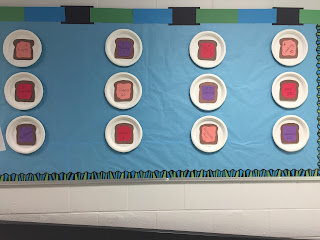With Chanukah starting on December 12th, I thought it might be helpful to share a tiny bit of information regarding dreidels and how you might incorporate dreidel play into a music lesson. I'm no expert, but I do know a thing or two.
Those Letters Actually Mean Something
First off, the Hebrew letters of the dreidel look like this:
 |
| Top left: nun, top right: gimel Bottom left: hei, bottom right: shin |
How to Play the Game
In traditional dreidel play, children have a handful of ______ to use for the game (gelt - chocolate coins, pennies, raisins, pennies, whatever). Each child places one ______ into the middle and takes turns at spinning the dreidel. Based on which letter faces up when the dreidel falls, the following possibilities will happen: nun = "none" as in nothing happens; gimel = "gimme" as in everyone has to give a piece of ______ to that player; hei = "half" as in the player takes half of what is in the middle; and shin = "share" as in that player has to give a piece of ______ to the middle. When there is nothing left in the middle, each child puts one ______ into the middle to continue play.
Now Add Music
Now that you've had your dreidel lesson, how can one incorporate dreidel play into the music room? Well, first off, sing some dreidel songs! "I Have a Little Dreidel" and "S'vivon" are the most common dreidel songs and will work just fine for the ideas I am sharing, but if you want something new, here's an original song I wrote a few years back:
Since the song is so short, i usually have my students sing it two or more times while we are playing a dreidel-like game. Singing and playing the dreidel game might be all that you care to do, but my creative juices have been flowing and there many other ideas for incorporating other musical possibilities into dreidel play.
Other Creative Possibilities
Create rhythmic ostinati based on assigned elemental rhythms: nun = quarter note, quarter rest; gimel = two quarter notes; hei = two eighth notes, quarter note; shin = four eighth notes. If a group of four students each spun the dreidel, their pattern might end up like this: shin hei
gimel hei = eighth eighth eighth eighth eighth eighth quarter quarter (rest) eighth eighth quarter (rest).
Create percussion ostinato based on letters. Again, each letter determines what to play. For example: nun = drum,
gimel = triangle, hei = wood block, shin = guiro. using the group of students above, their percussion ostinato would be: shin hei gimel
hei = guiro wood block guiro
triangle
Human Dreidel #1: divide the class into four groups (one for each letter). Give all students a small instrument to play (e.g. shakers or
sticks). Choose one student from each group to form a circle (the Human Dreidel)
and circle around as the class sings the song and taps the beat with instruments. Using a predetermined spot (a mark on the carpet, closest to the teacher, etc.) whatever letter comes up, that group has to give/receive one of their
instruments based on the rules of the game. Keep
playing until one group is left with instruments to play.
Human Dreidel #2: again, class is divided into four different
groups representing the four letters of the dreidel and a student from each group is selected to be the Human Dreidel. Each group is given a different instrument to play. First time around, the class
sings the song without instruments. As with the example above, whatever letter comes up,
that group gets to play instruments during the next turn. Keep playing until all teams have had a turn.








